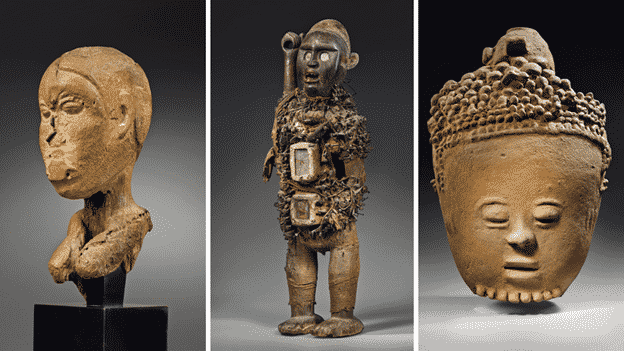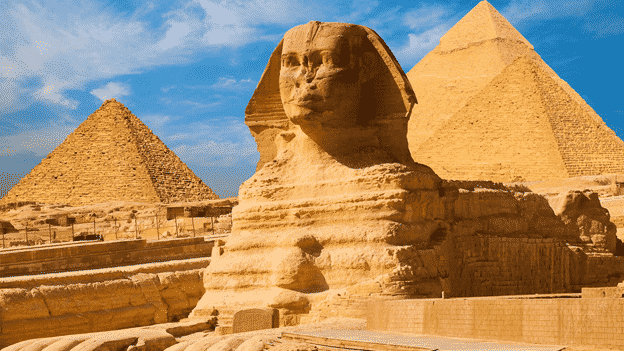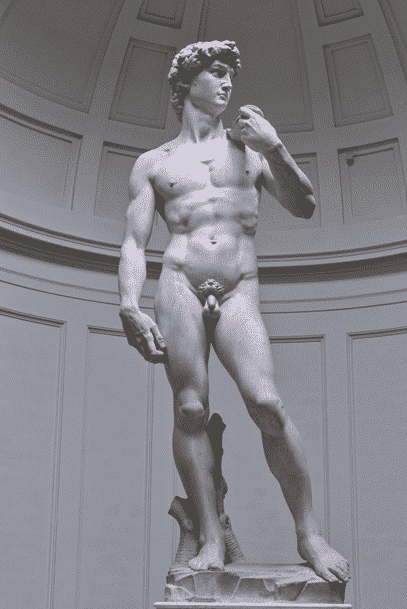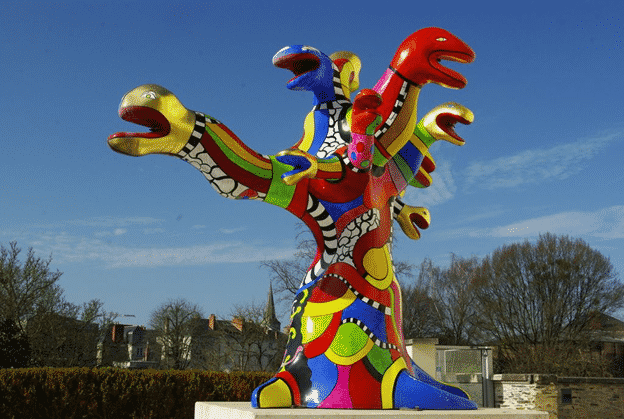Works of Art That Add Threedimensional Objects to the Canvas
3-dimensional art pieces, presented in the dimensions of pinnacle, width, and depth, occupy concrete space and tin be perceived from all sides and angles. On the other manus, two-dimensional works of art, which are created on apartment surfaces, can only be observed in terms of height and width. Traditional types of three-dimensional media, similar sculptures and reliefs, have been around since the beginning of man history every bit evidence of people's' need for artistic expression.
Sculptures take been predominant 3D fine art forms for centuries, evolving continually throughout unlike periods of art history. However, progressive fine art movements that boomed in the 20th century challenged the traditional perception of fine art, introducing anarchistic art mediums to limited their aesthetic and principles. This procedure resulted in the appearance of installation fine art and performance art every bit the contemporary variants of 3D media.
This commodity will present the development of these three-dimensional media throughout history, focusing on different art mediums and techniques used in creating 3D artworks worldwide.

The Traditional 3d Fine art Forms
In the beginning, people created statues out of rock and wood. The first preserved art object was a pocket-size, rock-carved female person figurine that dates back to 230,000 years B.C. There was an array of similar figurines found all over Europe. It is believed that these statues symbolized female fertility and played significant roles in various rituals and ceremonies. These roughly carved art pieces presented our ancestors' first attempts to apply natural materials to translate their beliefs into a concrete shape. Traditional iii-dimensional types of sculpture derived from these basic art pieces are:
- A free-standing sculpture
This is a dominant 3Dart grade that has been evolving since ancient times. As the name states, information technology is an contained art object that unremarkably represents people, animals, or abstract motives. Artists use stone, wood, or metal to create statues, and the selection of the right fine art medium depends on the size and complexity of the artwork.
- Reliefs
Equally opposed to free-continuing statues, relief sculptures sally from the groundwork equally elements of a larger piece of art. We can recognize several different types of reliefs. Bas reliefs represent three-dimensional compositions with statues slightly standing out against a groundwork. On the other hand, we have loftier relief artforms with statues projecting dominantly from the base. Sunk-relief is an fine art blazon commonly related to aboriginal Egypt, and it represented figures carved into the base of operations.
Different Techniques Practical in Creating 3d Art
Artists have practical various techniques to manipulate rock, wood, metallic, or dirt and transform them into desired fine art objects. The pick of fine art medium depends on the kind of statue you lot desire to make. Typically, people utilise the following art techniques when creating 3-dimensional art:
- Stone or wood carvingis a process of cutting out pieces of material until yous get the desired shape. This is one of the oldest art techniques that dates back to prehistoric times.
- Casting is an creative method applied when working with metal equally a called art medium. This artistic process involves pouring hot metal into pre-prepared molds to create colossal statues or compositions. Cast bronze sculptures are common representatives of this creative method.
- Weldingis a creative method of blending two metallic pieces to create a sculpture element. This technique is common in constructing three-dimensional pieces combining dissimilar elements.
- Drinking glass art techniquesinvolve handling hot, warm, or cold glass to shape and model this medium. In that location are various techniques applied in this creative process, including drinking glass bravado, casting, and sculpting. Cold drinking glass techniques are engraving, rubbing, sandblasting, and acrid etching.

Sculpture in Ancient Times
We will offer a short recapitulation of the development of sculpture as an fine art form, and we will outset with the ancient civilizations that get-go developed a distinctive creative style.
Ancient Egyptian Art
Sculptors in ancient Egypt were remarkably consistent in presenting anxiety, legs, and the head, accompanied by a frontal presentation of the torso and an eye. This seemed to exist the almost convenient way for them to finish every piece. Another typical Egyptian sculpture is a seated statue, and these were typically placed in the tombs of royalty and other respectable people. These luxurious imperial statues were usually accompanied by a number of smaller modest sculptures that represented the servants who needed to assistance their masters in another life. These smaller figures were also intricately sculpted.
The statue of the Sphinx is the virtually famous Egyptian landmark, and it stands to guard the entrance of the pyramids at Giza. With the body and head of a panthera leo and a human face, this is one of the most monumental statues of the ancient globe.
The Classical Ideal of Greek Sculpture
Aboriginal Greeks were the first to innovate the thought of beauty and proportion into art, thus setting the foundations for traditional Western fine art. They tended to cultivate the artistic style of heroic realism, presenting people in a naturalistic manner that required excellent skills. Ancient Greeks worshiped man dazzler and created nude statues to celebrate it. These nudes are among the greatest achievements of classical fine art.
Building and decorating the Parthenon marked the peak of classical Greek sculpture. The statues and reliefs for this ancient temple were finished within 10 years, involving an array of skilled sculptors. The tradition of using reliefs and statues as ornaments stems from this period, and it went on to boss the medieval European styles.
Indian Sculpture
Indian art dates back to the third centuryB.C. when the showtime Indian dynasty ruled. Sculptors created reliefs that depicted stories from the almost prominent Indian religions, Hinduism and Buddhism. The presentation of characters is mainly frontal every bit if they are facing a camera. The most staggering motif in Indian sculpture of that time is that of a full-breasted adult female captured in about unusual poses.

History of European Sculpture from The Center Ages to Mod Times
Medieval Sculpture
The most significant medieval European styles are Romanesque and Gothic. These styles are commonly related to architectural sculpture, where three-dimensional pieces of art decorated the church columns. Medieval sculptors let their imagination run wild when decorating these columns with vivid Biblical scenes and grotesque monsters. This was often met with strong disapproval of the church establishment. Gothic is another recognizable artistic manner that originates from the 12th century. Typical gothic sculptures are elongated and very sparse, standing on narrow pedestals, their bodies covered in robes and their faces beaming with serenity.
Renaissance
After the Eye Ages, the Renaissance came as a long-awaited period of liberation and reformation. This was one of the most significant and most fruitful periods in art history. When we talk virtually sculpture, everything revolves around Italy and great Italian masters who embraced the Greek platonic of beauty and proportion and incorporated it in their works of art.
Mikelangelo stands out among others with his extraordinary genius and vision of sculpture. The author ofDavid fix the bar high, creating a timeless masterpiece from a unmarried marble block that another sculptor had discarded.David is an example of an intricately detailed sculpture, and the facial expression perfectly depicts the mood.
Baroque
This 18th-century artistic style, warmly welcomed past the Roman church building, nourished excessive decoration and over-the-top details. This artistic style represented all the things Protestants despised -opulence, style, and detailed presentation of Biblical scenes.
Neoclassicism
Coming later on the over-accentuated Baroque period, Neoclassicism came equally the age of sobriety and returning to the values of classic art. Sculptors went back to worshipping the human body and creating sculptures with immaculate details.

Contemporary 3d Fine art Forms
The 20th century brought liberation from the ascendant influence of classic art. Rodin and another 19th-century sculptors inspired this shift with their works of art. Finally, sculptors started seeking other role models. African sculpture and Aztec masks had a meaning bear upon on three-dimensional artists.
This century besides marked the rising of glass art as a 3D fine art form. Artists started recognizing favorable features of drinking glass that allowed shaping and modeling. Present, there are significant glass art pieces, like sculptures and installations.
The art scene also witnessed the birth of installation and functioning every bit innovative 3D art forms. Artists decided to challenge sculpture as a dominant form and turned to creating big-calibration installations using anarchistic materials. In this way, they wanted to emphasize the bug they cared about and make them attainable to a broader audience.
Operation artists utilise their bodies as the medium to limited their artistic visions and principles. Performance art projects may involve an array of participants or just the author. These may be multimedia events with light effects or video projections, or they may rely on the author's interaction with the audience. Evidently, performance art allows authors to cull the perfect style to express themselves, and this is 1 of the most significant advantages of this artform.
Concluding Words
This concludes our account of the wide variety of three-dimensional art forms, following the development of three-dimensional media, from rock-carved prehistoric figurines to raw, improvisational and innovative fine art performances. This evolution process of gimmicky art will continue, especially with the assistance of advanced technologies like 3D printing that have a significant impact on the world of art.
Source: https://www.artdex.com/what-are-the-different-types-of-three-dimensional-art/
0 Response to "Works of Art That Add Threedimensional Objects to the Canvas"
ارسال یک نظر